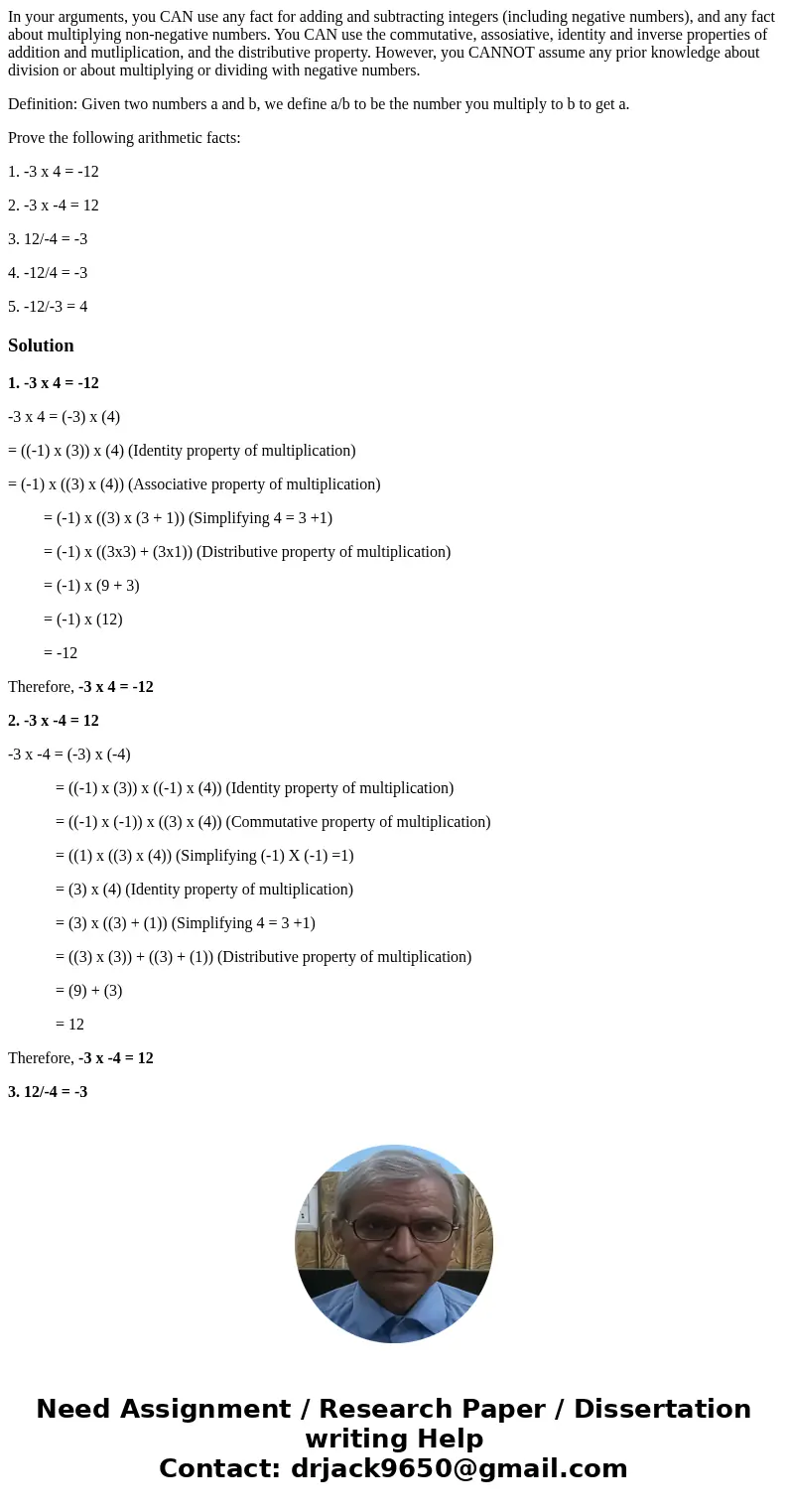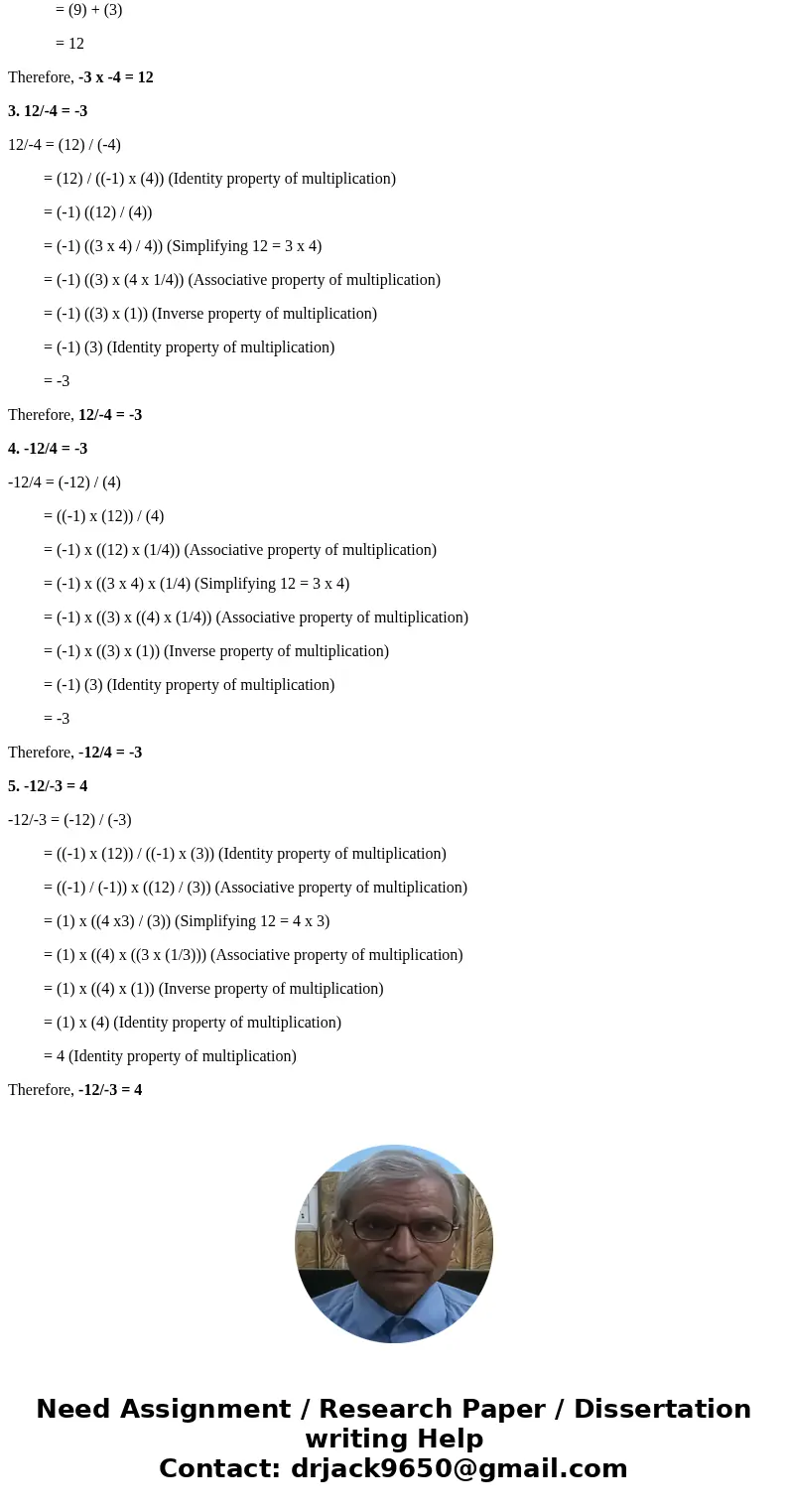In your arguments you CAN use any fact for adding and subtra
In your arguments, you CAN use any fact for adding and subtracting integers (including negative numbers), and any fact about multiplying non-negative numbers. You CAN use the commutative, assosiative, identity and inverse properties of addition and mutliplication, and the distributive property. However, you CANNOT assume any prior knowledge about division or about multiplying or dividing with negative numbers.
Definition: Given two numbers a and b, we define a/b to be the number you multiply to b to get a.
Prove the following arithmetic facts:
1. -3 x 4 = -12
2. -3 x -4 = 12
3. 12/-4 = -3
4. -12/4 = -3
5. -12/-3 = 4
Solution
1. -3 x 4 = -12
-3 x 4 = (-3) x (4)
= ((-1) x (3)) x (4) (Identity property of multiplication)
= (-1) x ((3) x (4)) (Associative property of multiplication)
= (-1) x ((3) x (3 + 1)) (Simplifying 4 = 3 +1)
= (-1) x ((3x3) + (3x1)) (Distributive property of multiplication)
= (-1) x (9 + 3)
= (-1) x (12)
= -12
Therefore, -3 x 4 = -12
2. -3 x -4 = 12
-3 x -4 = (-3) x (-4)
= ((-1) x (3)) x ((-1) x (4)) (Identity property of multiplication)
= ((-1) x (-1)) x ((3) x (4)) (Commutative property of multiplication)
= ((1) x ((3) x (4)) (Simplifying (-1) X (-1) =1)
= (3) x (4) (Identity property of multiplication)
= (3) x ((3) + (1)) (Simplifying 4 = 3 +1)
= ((3) x (3)) + ((3) + (1)) (Distributive property of multiplication)
= (9) + (3)
= 12
Therefore, -3 x -4 = 12
3. 12/-4 = -3
12/-4 = (12) / (-4)
= (12) / ((-1) x (4)) (Identity property of multiplication)
= (-1) ((12) / (4))
= (-1) ((3 x 4) / 4)) (Simplifying 12 = 3 x 4)
= (-1) ((3) x (4 x 1/4)) (Associative property of multiplication)
= (-1) ((3) x (1)) (Inverse property of multiplication)
= (-1) (3) (Identity property of multiplication)
= -3
Therefore, 12/-4 = -3
4. -12/4 = -3
-12/4 = (-12) / (4)
= ((-1) x (12)) / (4)
= (-1) x ((12) x (1/4)) (Associative property of multiplication)
= (-1) x ((3 x 4) x (1/4) (Simplifying 12 = 3 x 4)
= (-1) x ((3) x ((4) x (1/4)) (Associative property of multiplication)
= (-1) x ((3) x (1)) (Inverse property of multiplication)
= (-1) (3) (Identity property of multiplication)
= -3
Therefore, -12/4 = -3
5. -12/-3 = 4
-12/-3 = (-12) / (-3)
= ((-1) x (12)) / ((-1) x (3)) (Identity property of multiplication)
= ((-1) / (-1)) x ((12) / (3)) (Associative property of multiplication)
= (1) x ((4 x3) / (3)) (Simplifying 12 = 4 x 3)
= (1) x ((4) x ((3 x (1/3))) (Associative property of multiplication)
= (1) x ((4) x (1)) (Inverse property of multiplication)
= (1) x (4) (Identity property of multiplication)
= 4 (Identity property of multiplication)
Therefore, -12/-3 = 4


 Homework Sourse
Homework Sourse